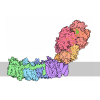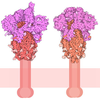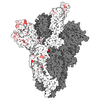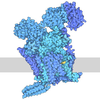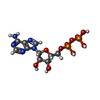[English] 日本語
 Yorodumi
Yorodumi- PDB-8vov: Structure of VCP in complex with an ATPase activator and ADP (D2 ... -
+ Open data
Open data
- Basic information
Basic information
| Entry | Database: PDB / ID: 8vov | ||||||
|---|---|---|---|---|---|---|---|
| Title | Structure of VCP in complex with an ATPase activator and ADP (D2 domains only, hexameric form) | ||||||
 Components Components | Transitional endoplasmic reticulum ATPase | ||||||
 Keywords Keywords | HYDROLASE/ACTIVATOR / activator / complex / ATPase / AAA protein / HYDROLASE / HYDROLASE-ACTIVATOR complex | ||||||
| Function / homology |  Function and homology information Function and homology information: / flavin adenine dinucleotide catabolic process / VCP-NSFL1C complex / endosome to lysosome transport via multivesicular body sorting pathway / endoplasmic reticulum stress-induced pre-emptive quality control / BAT3 complex binding / cellular response to arsenite ion / protein-DNA covalent cross-linking repair / Derlin-1 retrotranslocation complex / positive regulation of protein K63-linked deubiquitination ...: / flavin adenine dinucleotide catabolic process / VCP-NSFL1C complex / endosome to lysosome transport via multivesicular body sorting pathway / endoplasmic reticulum stress-induced pre-emptive quality control / BAT3 complex binding / cellular response to arsenite ion / protein-DNA covalent cross-linking repair / Derlin-1 retrotranslocation complex / positive regulation of protein K63-linked deubiquitination / cytoplasm protein quality control / positive regulation of oxidative phosphorylation / : / aggresome assembly / deubiquitinase activator activity / mitotic spindle disassembly / ubiquitin-modified protein reader activity / regulation of protein localization to chromatin / VCP-NPL4-UFD1 AAA ATPase complex / cellular response to misfolded protein / negative regulation of protein localization to chromatin / positive regulation of mitochondrial membrane potential / vesicle-fusing ATPase / K48-linked polyubiquitin modification-dependent protein binding / regulation of aerobic respiration / retrograde protein transport, ER to cytosol / stress granule disassembly / ATPase complex / regulation of synapse organization / ubiquitin-specific protease binding / positive regulation of ATP biosynthetic process / MHC class I protein binding / ubiquitin-like protein ligase binding / RHOH GTPase cycle / polyubiquitin modification-dependent protein binding / autophagosome maturation / negative regulation of hippo signaling / endoplasmic reticulum to Golgi vesicle-mediated transport / HSF1 activation / translesion synthesis / interstrand cross-link repair / ATP metabolic process / endoplasmic reticulum unfolded protein response / proteasomal protein catabolic process / Protein methylation / Attachment and Entry / ERAD pathway / lipid droplet / proteasome complex / viral genome replication / Josephin domain DUBs / N-glycan trimming in the ER and Calnexin/Calreticulin cycle / negative regulation of smoothened signaling pathway / macroautophagy / positive regulation of protein-containing complex assembly / Hh mutants are degraded by ERAD / establishment of protein localization / Hedgehog ligand biogenesis / Defective CFTR causes cystic fibrosis / positive regulation of non-canonical NF-kappaB signal transduction / Translesion Synthesis by POLH / ADP binding / ABC-family proteins mediated transport / autophagy / cytoplasmic stress granule / Aggrephagy / positive regulation of protein catabolic process / azurophil granule lumen / KEAP1-NFE2L2 pathway / Ovarian tumor domain proteases / positive regulation of canonical Wnt signaling pathway / positive regulation of proteasomal ubiquitin-dependent protein catabolic process / double-strand break repair / E3 ubiquitin ligases ubiquitinate target proteins / site of double-strand break / cellular response to heat / Neddylation / ubiquitin-dependent protein catabolic process / secretory granule lumen / protein phosphatase binding / regulation of apoptotic process / ficolin-1-rich granule lumen / proteasome-mediated ubiquitin-dependent protein catabolic process / Attachment and Entry / protein ubiquitination / ciliary basal body / protein domain specific binding / DNA repair / intracellular membrane-bounded organelle / lipid binding / ubiquitin protein ligase binding / DNA damage response / Neutrophil degranulation / endoplasmic reticulum membrane / perinuclear region of cytoplasm / glutamatergic synapse / endoplasmic reticulum / protein-containing complex / ATP hydrolysis activity / RNA binding Similarity search - Function | ||||||
| Biological species |  Homo sapiens (human) Homo sapiens (human) | ||||||
| Method | ELECTRON MICROSCOPY / single particle reconstruction / cryo EM / Resolution: 3.6 Å | ||||||
 Authors Authors | Jones, N.H. / Urnivicius, L. / Kapoor, T.M. | ||||||
| Funding support |  United States, 1items United States, 1items
| ||||||
 Citation Citation |  Journal: Proc Natl Acad Sci U S A / Year: 2024 Journal: Proc Natl Acad Sci U S A / Year: 2024Title: Allosteric activation of VCP, an AAA unfoldase, by small molecule mimicry. Authors: Natalie H Jones / Qiwen Liu / Linas Urnavicius / Noa E Dahan / Lauren E Vostal / Tarun M Kapoor /  Abstract: The loss of function of AAA (ATPases associated with diverse cellular activities) mechanoenzymes has been linked to diseases, and small molecules that activate these proteins can be powerful tools to ...The loss of function of AAA (ATPases associated with diverse cellular activities) mechanoenzymes has been linked to diseases, and small molecules that activate these proteins can be powerful tools to probe mechanisms and test therapeutic hypotheses. Unlike chemical inhibitors that can bind a single conformational state to block enzyme function, activator binding must be permissive to different conformational states needed for mechanochemistry. However, we do not know how AAA proteins can be activated by small molecules. Here, we focus on valosin-containing protein (VCP)/p97, an AAA unfoldase whose loss of function has been linked to protein aggregation-based disorders, to identify druggable sites for chemical activators. We identified VCP ATPase Activator 1 (VAA1), a compound that dose-dependently stimulates VCP ATPase activity up to ~threefold. Our cryo-EM studies resulted in structures (ranging from ~2.9 to 3.7 Å-resolution) of VCP in apo and ADP-bound states and revealed that VAA1 binds an allosteric pocket near the C-terminus in both states. Engineered mutations in the VAA1-binding site confer resistance to VAA1, and furthermore, modulate VCP activity. Mutation of a phenylalanine residue in the VCP C-terminal tail that can occupy the VAA1 binding site also stimulates ATPase activity, suggesting that VAA1 acts by mimicking this interaction. Together, our findings uncover a druggable allosteric site and a mechanism of enzyme regulation that can be tuned through small molecule mimicry. #1: Journal: bioRxiv / Year: 2023 Title: Allosteric activation of VCP, a AAA unfoldase, by small molecule mimicry. Authors: N H Jones / Q Liu / L Urnavicius / N E Dahan / L E Vostal / T M Kapoor Abstract: The loss of function of AAA (ATPases associated with diverse cellular activities) mechanoenzymes has been linked to diseases, and small molecules that activate these proteins can be powerful tools to ...The loss of function of AAA (ATPases associated with diverse cellular activities) mechanoenzymes has been linked to diseases, and small molecules that activate these proteins can be powerful tools to probe mechanisms and test therapeutic hypotheses. Unlike chemical inhibitors that can bind a single conformational state to block enzyme activity, activator binding must be permissive to different conformational states needed for enzyme function. However, we do not know how AAA proteins can be activated by small molecules. Here, we focus on valosin-containing protein (VCP)/p97, a AAA unfoldase whose loss of function has been linked to protein aggregation-based disorders, to identify druggable sites for chemical activators. We identified VCP Activator 1 (VA1), a compound that dose-dependently stimulates VCP ATPase activity up to ∼3-fold. Our cryo-EM studies resulted in structures (∼2.9-3.5 Å-resolution) of VCP in apo and ADP-bound states, and revealed VA1 binding an allosteric pocket near the C-terminus in both states. Engineered mutations in the VA1 binding site confer resistance to VA1, and furthermore, modulate VCP activity to a similar level as VA1-mediated activation. The VA1 binding site can alternatively be occupied by a phenylalanine residue in the VCP C-terminal tail, a motif that is post-translationally modified and interacts with cofactors. Together, our findings uncover a druggable allosteric site and a mechanism of enzyme regulation that can be tuned through small molecule mimicry. SIGNIFICANCE: The loss of function of valosin-containing protein (VCP/p97), a mechanoenzyme from the AAA superfamily that hydrolyzes ATP and uses the released energy to extract or unfold substrate ...SIGNIFICANCE: The loss of function of valosin-containing protein (VCP/p97), a mechanoenzyme from the AAA superfamily that hydrolyzes ATP and uses the released energy to extract or unfold substrate proteins, is linked to protein aggregation-based disorders. However, druggable allosteric sites to activate VCP, or any AAA mechanoenzyme, have not been identified. Here, we report cryo-EM structures of VCP in two states in complex with VA1, a compound we identified that dose-dependently stimulates VCP's ATP hydrolysis activity. The VA1 binding site can also be occupied by a phenylalanine residue in the VCP C-terminal tail, suggesting that VA1 acts through mimicry of this interaction. Our study reveals a druggable allosteric site and a mechanism of enzyme regulation. | ||||||
| History |
|
- Structure visualization
Structure visualization
| Structure viewer | Molecule:  Molmil Molmil Jmol/JSmol Jmol/JSmol |
|---|
- Downloads & links
Downloads & links
- Download
Download
| PDBx/mmCIF format |  8vov.cif.gz 8vov.cif.gz | 347.2 KB | Display |  PDBx/mmCIF format PDBx/mmCIF format |
|---|---|---|---|---|
| PDB format |  pdb8vov.ent.gz pdb8vov.ent.gz | Display |  PDB format PDB format | |
| PDBx/mmJSON format |  8vov.json.gz 8vov.json.gz | Tree view |  PDBx/mmJSON format PDBx/mmJSON format | |
| Others |  Other downloads Other downloads |
-Validation report
| Summary document |  8vov_validation.pdf.gz 8vov_validation.pdf.gz | 1.8 MB | Display |  wwPDB validaton report wwPDB validaton report |
|---|---|---|---|---|
| Full document |  8vov_full_validation.pdf.gz 8vov_full_validation.pdf.gz | 1.9 MB | Display | |
| Data in XML |  8vov_validation.xml.gz 8vov_validation.xml.gz | 69.1 KB | Display | |
| Data in CIF |  8vov_validation.cif.gz 8vov_validation.cif.gz | 95.1 KB | Display | |
| Arichive directory |  https://data.pdbj.org/pub/pdb/validation_reports/vo/8vov https://data.pdbj.org/pub/pdb/validation_reports/vo/8vov ftp://data.pdbj.org/pub/pdb/validation_reports/vo/8vov ftp://data.pdbj.org/pub/pdb/validation_reports/vo/8vov | HTTPS FTP |
-Related structure data
| Related structure data |  43392MC 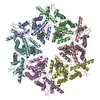 8vkuC 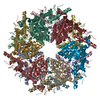 8vlsC C: citing same article ( M: map data used to model this data |
|---|---|
| Similar structure data | Similarity search - Function & homology  F&H Search F&H Search |
- Links
Links
- Assembly
Assembly
| Deposited unit | 
|
|---|---|
| 1 |
|
- Components
Components
| #1: Protein | Mass: 89436.820 Da / Num. of mol.: 6 Source method: isolated from a genetically manipulated source Source: (gene. exp.)  Homo sapiens (human) / Gene: VCP / Production host: Homo sapiens (human) / Gene: VCP / Production host:  #2: Chemical | ChemComp-ADP / #3: Chemical | ChemComp-A1AC1 / ( Mass: 354.466 Da / Num. of mol.: 6 / Source method: obtained synthetically / Formula: C20H22N2O2S / Feature type: SUBJECT OF INVESTIGATION Has ligand of interest | Y | |
|---|
-Experimental details
-Experiment
| Experiment | Method: ELECTRON MICROSCOPY |
|---|---|
| EM experiment | Aggregation state: PARTICLE / 3D reconstruction method: single particle reconstruction |
- Sample preparation
Sample preparation
| Component | Name: Complex of VCP with ADP and ATPase activator small molecule VAA1 Type: COMPLEX / Entity ID: #1 / Source: RECOMBINANT | |||||||||||||||||||||||||||||||||||
|---|---|---|---|---|---|---|---|---|---|---|---|---|---|---|---|---|---|---|---|---|---|---|---|---|---|---|---|---|---|---|---|---|---|---|---|---|
| Source (natural) | Organism:  Homo sapiens (human) Homo sapiens (human) | |||||||||||||||||||||||||||||||||||
| Source (recombinant) | Organism:  | |||||||||||||||||||||||||||||||||||
| Buffer solution | pH: 7.5 Details: 50 mM K.HEPES pH 7.5, 25 mM KCl, 2.5 mM MgCl2, 2.5 mM GSH, 0.5% DMSO, 0.01% FOM | |||||||||||||||||||||||||||||||||||
| Buffer component |
| |||||||||||||||||||||||||||||||||||
| Specimen | Conc.: 1 mg/ml / Embedding applied: NO / Shadowing applied: NO / Staining applied: NO / Vitrification applied: YES | |||||||||||||||||||||||||||||||||||
| Specimen support | Grid material: COPPER / Grid mesh size: 300 divisions/in. / Grid type: Quantifoil R2/2 | |||||||||||||||||||||||||||||||||||
| Vitrification | Instrument: FEI VITROBOT MARK IV / Cryogen name: ETHANE / Humidity: 100 % / Chamber temperature: 298 K |
- Electron microscopy imaging
Electron microscopy imaging
| Experimental equipment |  Model: Titan Krios / Image courtesy: FEI Company |
|---|---|
| Microscopy | Model: FEI TITAN KRIOS |
| Electron gun | Electron source:  FIELD EMISSION GUN / Accelerating voltage: 300 kV / Illumination mode: FLOOD BEAM FIELD EMISSION GUN / Accelerating voltage: 300 kV / Illumination mode: FLOOD BEAM |
| Electron lens | Mode: BRIGHT FIELD / Nominal defocus max: 3500 nm / Nominal defocus min: 500 nm |
| Image recording | Electron dose: 38.3 e/Å2 / Film or detector model: GATAN K3 (6k x 4k) |
- Processing
Processing
| EM software | Name: PHENIX / Version: 1.20.1_4487: / Category: model refinement | ||||||||||||||||||||||||
|---|---|---|---|---|---|---|---|---|---|---|---|---|---|---|---|---|---|---|---|---|---|---|---|---|---|
| CTF correction | Type: PHASE FLIPPING AND AMPLITUDE CORRECTION | ||||||||||||||||||||||||
| Particle selection | Num. of particles selected: 15016678 / Details: Autopicking | ||||||||||||||||||||||||
| Symmetry | Point symmetry: C6 (6 fold cyclic) | ||||||||||||||||||||||||
| 3D reconstruction | Resolution: 3.6 Å / Resolution method: FSC 0.143 CUT-OFF / Num. of particles: 148297 / Symmetry type: POINT | ||||||||||||||||||||||||
| Atomic model building | Space: REAL | ||||||||||||||||||||||||
| Atomic model building | PDB-ID: 5FTL Accession code: 5FTL / Source name: PDB / Type: experimental model | ||||||||||||||||||||||||
| Refine LS restraints |
|
 Movie
Movie Controller
Controller




 PDBj
PDBj


